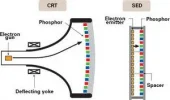- Joined
- Mar 16, 2002
- Messages
- 6,660
- Reaction score
- 578
Those who bought the LCD displays recently thinking that now is the time as most of the teething problems are sorted are in for a surprise when they find out it is already obsolete. Canon and Toshiba announce new flat screen display which they call SED (Surface-conduction Emission Display).
Two to three decades back any new technology was allowed to mature and would last a decade. The way new technology is being adopted we will not have any one maturing and we would have to abandon it before we can reap the rewards. The consumer is surely the loser since the develpment cost is also paid by them and not those who introduce it.
Canon and Toshiba have teamed up to produce this new flat-screen technology which will be superior to current displays available today. The three main improvements are:
SED (Surface-conduction Emission Display) works by using a thin film of Palladium Oxide as an electron emitter which strike a layer of phosphor, just like in a traditional CRT screen. Electrons are emitted at each sub-pixel, and so higher resolution and contrast is achievable. None of the problems associated with LCD screens should affect this technology either because phosphors are illuminated instead of using a backlit display as found in LCDs.
- Response time - slower response times found on LCD displays can lead to ghosting.
- Contrast ratio - reported to be 100.000:1, the best LCDs currently only have a contrast ratio of 1000:1.
- Viewing angle - up to 180º, LCD screens can appear dark if they are not viewed straight-on.
The greater clarity of these new displays will be ideal for photographers and graphic artists, for whom colour accuracy is critical.
Canon hope to be able to market this innovation in the form of televisions by winter 2007. Canon have refused to comment on when this technology will be available for computer monitors, only saying, "There are plans for production, but no details of (SED) monitors can be released at this time."
Source: ePhotozine
Two to three decades back any new technology was allowed to mature and would last a decade. The way new technology is being adopted we will not have any one maturing and we would have to abandon it before we can reap the rewards. The consumer is surely the loser since the develpment cost is also paid by them and not those who introduce it.





